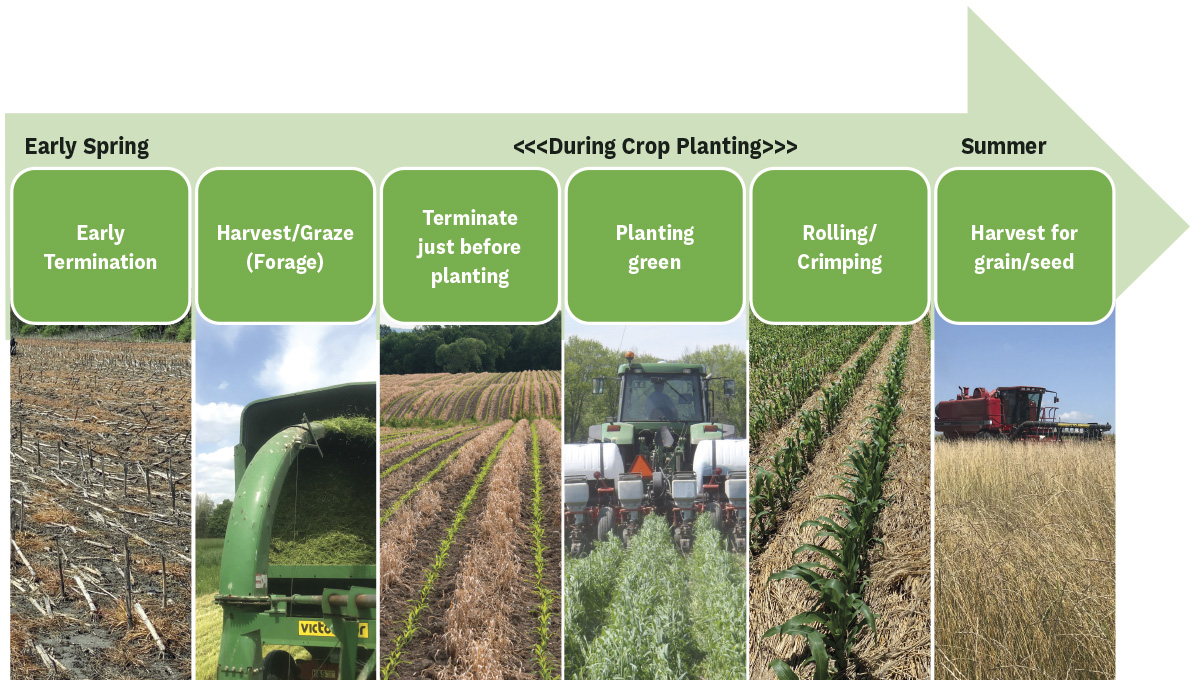According to the 2017 USDA Agriculture Census, Northeast farms are planting over one million acres of cover crops, and momentum for this conservation practice continues to grow because of its crop, soil, and environmental benefit. Increasing financial incentives coupled with environmental regulations have pushed even more farmers to adopt cover crops. However, like any other crop grown on the farm, the benefits will only be realized with proper planning and timely management.
To make cover crops a successful part of crop rotation, especially in the Northeast, it is important to be creative and adaptable. Cover cropping works the best when it is an integral part of the farm’s cropping system, not just an afterthought. This is imperative to realize the biggest benefits of utilizing this practice, but also to mitigate any of the potential pitfalls. With spring knocking on our door, our focus is on the best strategies to terminate winter cereal cover crops. Emphasis is on being flexible based on weather, field conditions, and management goals. The best plan is to always have a backup plan!
Spring termination strategies for winter cereal cover crops in the Northeast

EARLY TERMINATION
Early adopters of cover crops may “fear the cover crop” especially come spring! The first impulse is to get rid of it as soon as possible so it doesn’t interfere with cropping activities. This is a normal response, but as experience and knowledge builds, so will ability to manage the cover crop in the spring to maximize benefits and minimize challenges. In many cases if spring conditions are dry, it may be advisable to terminate the cover crop so that soil moisture is conserved for the cash crop. The cover crop begins to grow much earlier than most grass species and will actively remove moisture and nutrients from the soil. This obviously can be helpful if it is wet, but detrimental to the subsequent crop if conditions remain dry. Early termination generally results in low cover crop growth resulting in minimal organic matter additions and nitrogen (N) credits. For farmers interested in higher cover crop biomass that still terminates early, consider sowing a winter tender species like oats, radishes or annual legumes that will kill with winter frost, keeping in mind these should be planted late summer or early fall.
HARVEST OR GRAZE AS FORAGE
Harvesting or grazing a cover crop for forage provides a measurable benefit and return on a planting investment. It can be challenging to fit this harvest into the busy spring, but if timed properly (flag leaf or boot stage), between one and four tons of high-quality dry matter can be harvested in May, which can be especially helpful if feed inventories are getting low. A timely harvest means that feed quality can be exceptional, with over 65 percent of the fiber being digested in 30 hours. Target highest fertility fields with the highest seeding rates (think lots of biomass), but don’t mortgage ruining your soils with compaction if field conditions are not conducive to equipment or livestock - creating compaction and mud. 50 pounds of N fertilizer at green-up will boost protein content, and often yields. Because a lot of biomass is removed from the field, a N credit is not reaped for the following crop. If manure is to be applied on these fields, applying in fall is best to avoid possible feed contamination, or it can be a great place for manure between cover crop harvest and cash crop planting. With increased total crop N removal, higher annual application rates in the nutrient management plan can be justified. Be realistic about how many acres of cover crop that can be harvested. Winter cereal grains grow quickly in the spring and can get overmature in a matter of days. Target a few fields until sure of capacity.
CONVENTIONAL TERMINATION TIMING
Many farmers terminate the cover crop just prior to corn planting (seven to 10 days) or before the stems begin to elongate. There are many advantages to terminating at this time/stage. First, if the cover crop is terminated through tillage, it is easier to incorporate and may take fewer passes through the field. It also is generally easier for most no-till planters to push through the biomass and less chance for the cover crop to impede corn seedling growth. Cover crops incorporated at this stage can also provide some N credit to the subsequent corn crop, ranging from 25 to 45 pounds of N per acre. Of course, this is highly dependent on the amount of cover crop biomass, prior fertility, and stage at incorporation. Using a pre-sidedress nitrate test (PSNT) is a good way to determine N that has come available from the cover crop and manure. Many farmers select the time of termination based on moisture content of the soil, letting the cover crop grow closer to planting to reduce soil moisture in wet years or terminating earlier if the spring is dry. Herbicide termination too close to the time of planting might cause issues with the planter as the cover crop can become wiry and wrap-up around the coulters and row cleaners and ultimately plug up the planter. Manure can be applied on these fields as soon as field conditions are good in the spring, minimizing losses, but also getting it on soon enough to not impede cover crop herbicide termination.
PLANTING GREEN
Planting corn directly through a living cover crop prior to terminating it has become a popular approach because of the flexibility it allows the farmer to plant corn when the conditions are right without needing to worry about terminating the cover crop first. This maximizes the benefits of the cover crop by allowing it to grow as long as possible without getting overmature. It is often easier for a corn planter to work effectively, as the cover crop is still green and anchored to the soil, preventing wrapping on row cleaners and closing wheels or pinning residue in the furrow. However, once the corn is planted it is important to terminate the cover crop quickly to keep the cover crop from impeding corn growth and development. In-season nitrogen return is generally minimal when the cover crop is terminated through herbicide application. However, this really depends on the stage of termination, biomass, and weather. A PSNT is the best tool to determine N contributions. If the cover crop has elongated and heads are visible or nearly visible, the corn crop may require additional early nitrogen since the cover crop will be slower to decompose and release N. This approach also offers a lot of flexibility for manure applications as manure can be applied anytime from the fall through spring on a living crop, reducing nutrient loss and runoff risk.
ROLLING AND CRIMPING
Cover crops can be mechanically terminated with a process that involves rolling down of the cover crop while simultaneously crimping the stems. This practice is gaining favor as a tool to manage cover crops that have “gone by” and with organic farmers interested in reducing tillage. Farmers are generally striving to terminate the cover crop before it begins to head/flower to minimize issues with planting of the cash crop. However in wet years many farmers have found it difficult to get in the field and terminate the cover crop whether they have planted green or not. Once the cover crop has fully headed, biomass quantities can be very high and herbicides are less effective. The cereal grain is tall and even if the corn or soybeans are already planted, it can severely impede corn growth and development due to shading and nitrogen tie up. Rolling and crimping the cover crop is a proven method to terminate a cover crop that is flowering and can be done before or after the annual cash crop is planted. Special equipment (a roller-crimper) is required and can even be mounted on the planter. Benefits to rolling and crimping include soil erosion protection, weed suppression, and keeping the soil cooler and retaining moisture during the hot summer months. It does, however, take intensive management and there are many considerations to take into account. This strategy can work particularly well for soybeans and is covered in much more detail in this guidebook: Organic no-till planted soybean production guide.
HARVEST FOR GRAIN, SEED, OR STRAW
Many farmers have been interested in taking the winter cereal grains to maturity, at least on some acres, to produce their own grain, cover crop seed or straw. Growing grain for seed may require additional equipment such as a combine, drier, seed cleaner, and some type of storage. However, it can save the farm input costs and help to diversify the farm rotation. Winter cereal grains are harvested between July and August depending on location in the Northeast. Yields can range from one to four tons depending on the environment. Even at a low yield of 3,000 pounds per acre is enough seed to plant 30 to 40 acres of cover crop. The straw is then available for bedding, feed or to sell off-farm for additional revenue. The crop is harvested early enough to allow for a summer new perennial seeding or a legume cover crop ahead of corn or sorghum the next year. It also opens a summer window to spread manure.
ECONOMICS
Many farmers believe the scientific evidence that soil health practices improve soil and water quality, but may be reluctant to change management techniques without knowing how it will impact their bottom line. Steve Gould of HaR-Go Farms, an organic dairy in western New York, has been “double cropping” or harvesting triticale in the early spring, and has found economic as well as soil health benefits while doing so. Not only is the farm increasing forage by about three tons per acre each year, a partial budget analysis shows an annual net value of harvesting triticale as forage of $123 per acre once seed and harvest costs are considered. To learn more about the costs and benefits of adopting soil health practices, like including cover crops into the crop rotation and potential for a return on investment, visit: Farmland Information Center.
New to cover cropping or just want more information? Try these resources:
- Need more information on cover crops? Northeast Cover Crops Council’s website has some great tools available to help make decisions about species, seeding rates, planting dates, and more. Visit Northeast Cover Crops.
- A great general cover crop handbook is available from SARE: Managing Cover Crops Profitably.
- Looking for federal cost share programs? USDA-Natural Resource Conservation Service (NRCS) has several incentive programs designed to help defray the cost of cover cropping. Learn more about these initiatives or find a NRCS office near you at ncrs.usda.gov.
- Want to see what your local area offers for cover crop support? Check with your state government’s Agriculture Department or your county’s Soil and Water Conservation District for local programs and technical assistance. Many of these programs are focused on water quality, climate smart farming/greenhouse gas, soil health, and other initiatives.
- Worried about your crop insurance? NRCS and Farm Service Agency (FSA) have updated a coordinated policy regarding cover crop termination and have guidance here: RMA Cover-Crops NRCS Guidelines.
- Find Extension and university resources by state by visiting Northeast Cover Crops Council (NECCC) resources page and click on your state.

This article appeared in PRO-DAIRY's The Manager in March 2023. To learn more about Cornell CALS PRO-DAIRY, visit PRO-DAIRY.





